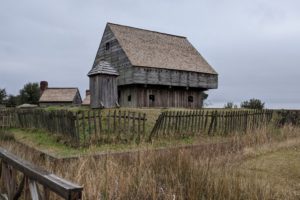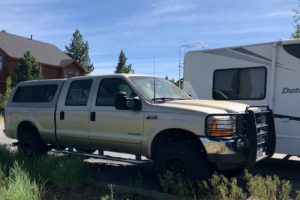Wanting to stay in the southern part of Georgia where it’s a little warmer, we drove a couple of hours east toward Douglas in the center of state to General Coffee State Park. Wonder if they provide coffee each morning?

then
One of southern Georgia’s “best kept secrets,” this park is known for agricultural history shown at Heritage Farm, with log cabins, a corn crib, tobacco barn, cane mill, and other exhibits. Farm animals usually include goats, sheep, chickens, pigs, and donkeys. (I’ll include pictures of this farm later on in the post.)
now
The Seventeen-Mile River and a boardwalk wind through cypress swamp where rare and endangered plants grow. Pitcher plants, shy indigo snakes and gopher tortoises make their homes in this wiregrass community.
We weren’t sure what pitcher plants are so looked them up on Wikipedia: “Pitcher plants are several different carnivorous plants which have modified leaves known as pitfall traps—a prey-trapping mechanism featuring a deep cavity filled with digestive liquid. The traps of what are considered to be “true” pitcher plants are formed by specialized leaves.”

Birding and nature photography are exceptional. For horse lovers, the park offers 13.4 miles of equestrian trails and primitive ride-in campsites.
campground
This campground is beautiful and so empty! Here are pictures of what we lived with for a few days.




One of my big problems with summer is mosquitoes. Since we love to sit outside, Barney started investigating how we could be protected while traveling. On FaceBook we saw this product advertised.

gopher tortoise
Since this park features this tortoise, we started wondering what the difference is between a tortoise and a turtle. Do you know? Well, tortoises live on land, while turtles lives mainly in the water. Now we both know.
On our first hike around the park, we saw this burrow in the ground and wondered what it was for.

We read that tortoises dig out these burrows that can go down 6 feet and out 30 feet. More than 300 other animals and insects also live in these burrows, making it a keystone species. The tortoise’s name comes from the deep burrows it digs, like a gopher. This large tortoise, which can weigh up to 15 pounds, has scaly, shovel-like front legs that are specialized for digging. It lives in the southeastern United States and is the only land tortoise native to the area.
The soft ground outside of the opening from the tortoise burrowing into the ground is where the babies (in eggs) are buried. Notes from the state park warned us not to step on this area or on the top of the opening because it can cave in. Oops, glad we didn’t do that.
One day a tortoise came to visit us at our campsite.

At the campground’s bathroom, Barney saw this gopher tortoise coming up to sun itself.

We didn’t see any snakes as we walked around. Phew.
hikes along the river
We saw this map of the Seventeen Mile River running through the park while we were on one of our walks. We were able to start on the hike just outside of our campsite. The 2 long hikes were on the east and west sides of the river.


The river is also known as a blackwater river because of its darkly stained acidic water coming from tannins leaching into the water as vegetation decays.
area history
About 13,000 years ago, Paleoindians began to live in Georgia. These hunter-gathers camped here seasonally as early as 8000 years ago. By the mid-1800s, subsistence farms dotted the area. The railroad to a nearby town brought people and industries to the area.

The walk to the Heritage Farm was lovely, but we really had to watch where we were stepping because of the tree roots.

Here’s some of what we learned as we were walking.

In the longleaf pine forest, controlled fires have cleared out the trees that keep the longleaf pine from growing so it’s making a comeback. So why is this tree so important? Turpentine.

Along with this long life span, the tree’s natural response to injury (oozing of sticky sap) made the tree important for the turpentine industry. Workers would cut the bark off of the trees to collect the pine sap that would then be taken to a turpentine still to be processed into various products. Much of the upland area of the park was used in turpentine production until the land was sold in 1970 to become a state park. Most of turpentine today is synthetically produced.
uses: Turpentine has been used primarily as a solvent and for fuel. A residue from the distilling process was rosin that was used to reduce the harshness of lye soap. In the 1700s, turpentine was used for lamp oil and in the manufacturing of medicines, paints, and rubber goods.
Heritage Farm
As we came to the end of the trail, we came upon the park’s lake that is used by visitors for canoeing and kayaking. You can see the stored boats in this picture.


This farm area shows how people lived during the time of General Coffee (1782 to 1836).
Meeks log cabin
Our first stop while walking around the farm is the Meeks log cabin. Charles Meeks settled 2 miles from here in 1830 and had a hired hand named Thomas build this cabin the next year, and he became the first person to live in the cabin. This cabin is probably the oldest log cabin in south Georgia.




Outside of the cabin is a view of some of the other buildings on the farm.
outhouse


smokehouse
My grandpa also had a smokehouse on his farm that was located just outside of the farmhouse. By the time I started visiting the farm, the smokehouse was no longer used since he had refrigeration. But we could always smell the smoke as we walked by on the way to the outhouse. Dad remembered using the smokehouse when he was a child growing on the farm in the early 1900s.

Outside and inside of the smokehouse.
Salting required that the fresh meat be covered with salt and put in boxes or barrels to “cure” or “take the salt.” Cool weather in the fall and winter helped preserve the meat in the saltboxes. When the weather warmed, the meat would be taken and washed prior to cooking and eating.
chicken coop
On my grandpa’s farm all of the chickens (rosters and hens) were free to walk wherever they wanted—the beginning of open range chickens. This also meant that we had to walk around chicken poop as we walked to the outhouse, and I only had city-girl shoes to wear. Not my favorite childhood memory.

mule and hay barn

They barns provided shelter for farm animals and storage for hay and feed. The logs were set apart to allow for air circulation. Sometimes pegs were stuck between the logs to catch the hay and keep it from being trampled on the ground. Often a second level would be added for storing grain and feed. The roof line was extended on the sides to form shelter from the weather and provide extra storage space for farm equipment.
tobacco barn


The heat source to the left of the front door is a traditional wood-burning firebox.
Many people would work together to cut and bundle the leaves, tie them onto “tobacco sticks,” and hang them on the cross beams in the barn.
The temperature inside the building needed to be controlled between 80-160 degrees for about a week to cure the tobacco leaves. Then they were then placed in large baskets, covered with burlap, and taken to market.
Tobacco was a major cash crop in this area of Georgia during the early 1900s. Barns such as this one were quickly replaced in the 1920s and 30s with smaller barns called “bunk barns” that could be heated more efficiently. These smaller barns can still be seen on many local farms.
syrup boiler/hog scalder and cane press

The cane press is on the right of the syrup shed.

Relihan cabin, now a museum

I tried to find out where this cabin came from and couldn’t find any info online. A Relihan family owns a funeral home in south Georgia, but I don’t know if they have a connection to this cabin. Let me know if you have any information.


We had a great time at General Coffee State Park, and no, they didn’t provide coffee for the campers. Sigh.
So much to see in this area but places are closed for now. We’ve seen some but look forward to returning to see the rest of the area.
home
The day after we got home, our neighborhood J. Christopher’s opened for inside dining so we joined them for lunch on the patio. Such a favorite spot for us!

We’re home for about 10 days and then will take off for a 3-week trip to other state parks in southern Georgia.




















